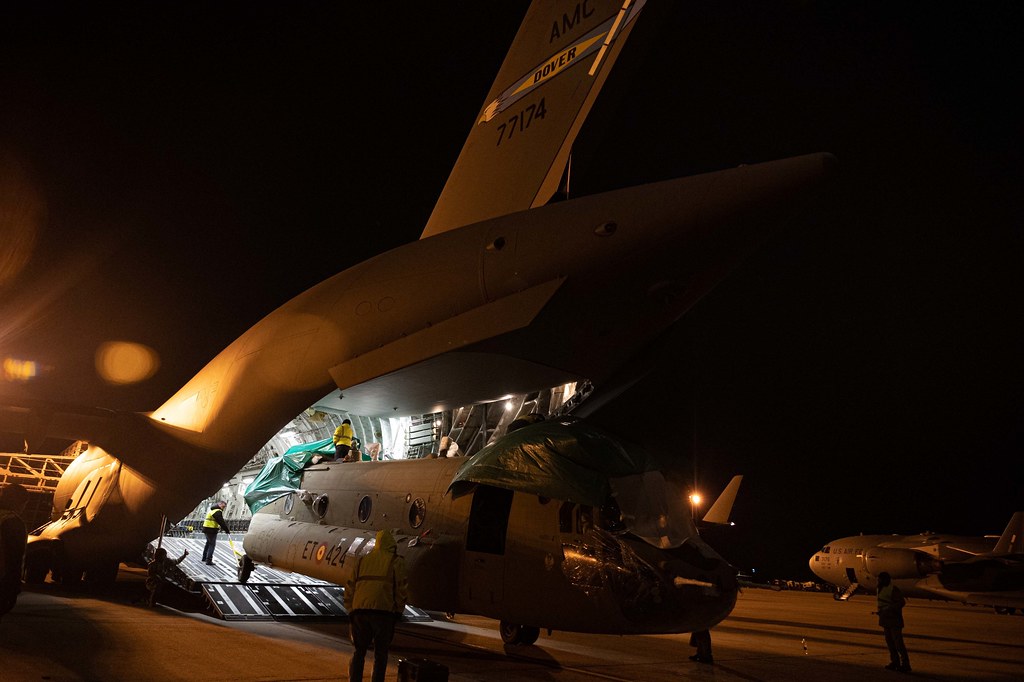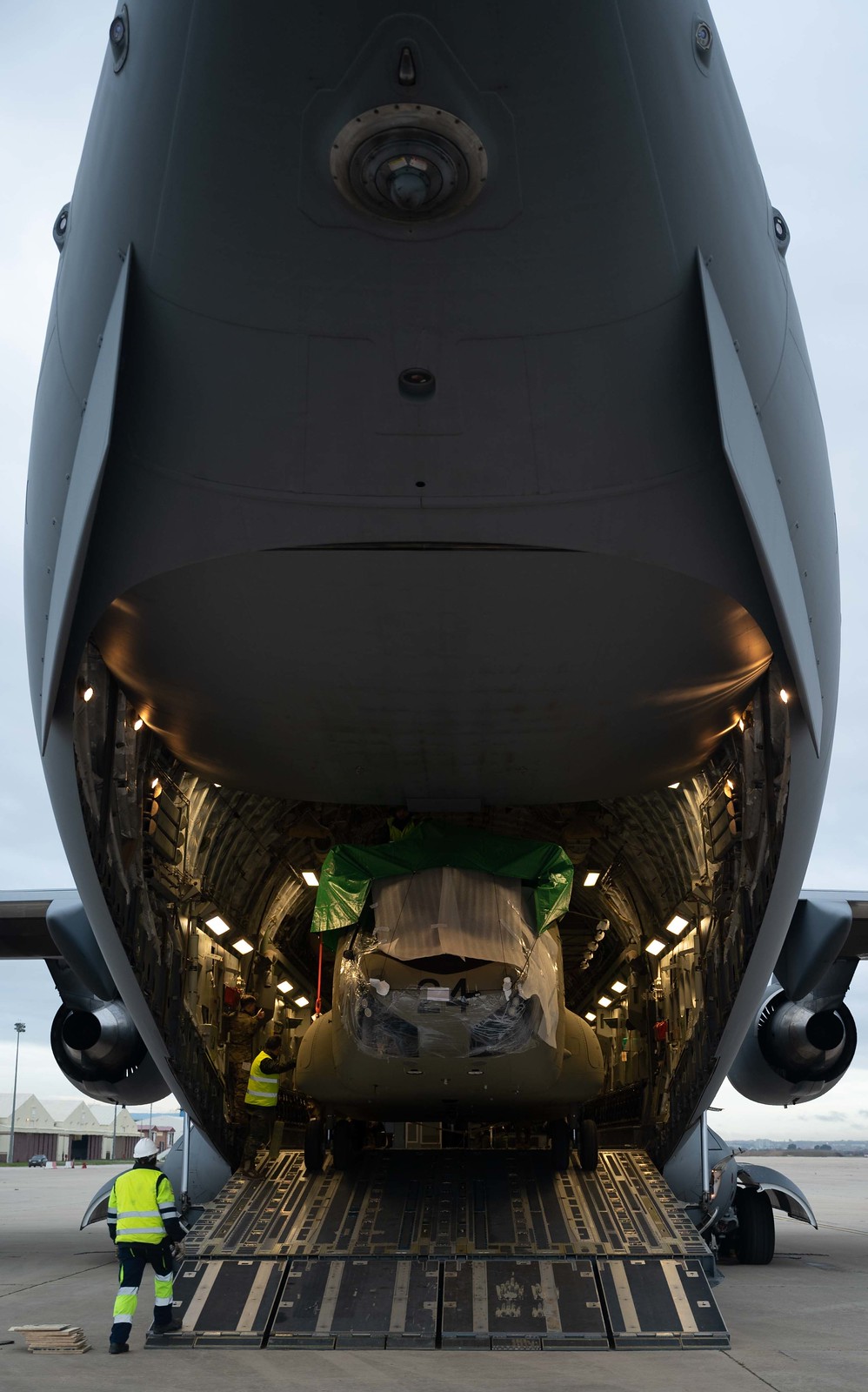The delivery operation of a CH-47F Chinook helicopter to Spain with an American C-17
The Army is renewing its fleet of 17 CH-47D Chinook heavy helicopters to the CH-47F version, a modernization that is done in the US.
The modernization takes place at the Boeing Helicopter Company factory in Ridley Park, Philadelphia, Pennsylvania. What is being done is to take advantage of 39 components of the CH-47D that the Army Air Mobile Forces (FAMET) have, among them the two Honeywell T55-GA-714A turbines, the main transmission and the combination, the generators and the blades of the two rotors.
Basically, a CH-47D is sent to the US and returned to Spain converted into a CH-47E, with the characteristic khaki paint that these helicopters use in the US Army, instead of decoration olive green or the three-color camouflage used by the Spanish CH-47Ds. The old fuselages are discarded and new ones are made with carbon fiber, in addition to incorporating various improvements in avionics, a digitized cockpit and improvements to the fuselage that will simplify and reduce maintenance tasks. The program, which was authorized by the US in 2018, has an amount of 1,300 million dollars.
The first Spanish CH-47F -HT.17-20, with number ET-420- arrived in Santander by boat on November 25, 2021, with the rotors disassembled, and was presented to the public on February 1. 2022 at the "Coronel Maté" Base of the FAMET in Colmenar Viejo (Madrid). The new CH-47F are incorporating new correlative numerals to those already existing on the CH-47D (starting with the ET-420), as if they were new helicopters, but they keep their original number plates. On January 16, the CH-47F ET-424 arrived at the Torrejón Air Base, in Madrid, from Dover AFB, in Delaware. The United States Air Force (USAF) has published a series of photos of the delivery of this helicopter in Torrejón. You can see some of them below.

USAF personnel loading the Spanish CH-47F onto a C-17, number 77174, at Dover AFB on January 14. In order to fit this heavy helicopter onto the C-17, its rotors had to be dismantled and their turbines.

A ramp operator from the USAF 436th Aerial Port Squadron observes the loading process of the Spanish CH-47F aboard the C-17 at Dover AFB.

A USAF airman winds up a winch of the C-17 Globemaster III carrying a Spanish CH-47F on January 14, prior to its takeoff from Dover AFB. This C-17 belongs to the 3rd Airlift Squadron of the 436th Airlift Wing.

The USAF C-17 Globemaster III transport plane upon arrival in Torrejón. The arrival took place at dawn, before dawn.

The C-17 flying over the Atlantic Ocean in the early morning of January 16. The commander of the plane that transported the CH-47F to Spain was Captain Jon Hobbs of the 3rd Airlift Squadron.

The C-17 in its approach to the Torrejón Air Base. It was still night.

The C-17 with its ramp open after landing in Torrejón. The image shows the tarpaulins placed to protect the cockpit of the Spanish CH-47F.

A command of the Army speaking with a USAF aviator inside the C-17, at the beginning of the unloading process of the Spanish CH-47F.

The beginning of the unloading of the Spanish CH-47F. The front wheels of the helicopter are already on the ramp of the C-17. Army personnel collaborated in the unloading operation.

Another moment of the unloading of the CH-47F. The unloading was done using the winch of the C-17. Inside the plane, behind a soldier from the Army, we can see the winch operator looking towards the helicopter.

The CH-47F outside the C-17, at the moment of finishing the unloading process. Above the helicopter we can see two members of the Transport Helicopter Battalion V (BHELTRA V) of the FAMET, wearing yellow vests.
|
Don't miss the news and content that interest you. Receive the free daily newsletter in your email: |
- Most read
- The 'hole' without civil flights around Paris during the opening of the Olympic Games
- Stunning footage of the F-15QA Ababil in flight recorded from its cockpit
- The firearms used by the Pontifical Swiss Guard, the smallest army in the world
- Eurofighter vs F-35: the opinions of professional pilots on these advanced fighters
- The first photo of an F-16 fighter with Ukrainian insignia and the details it has revealed
- The most distant deployment of the Spanish Air Force in Australia and New Zealand
- This is the driver station of an M1 Abrams tank and the impressive start of its engine

 ES
ES







Opina sobre esta entrada: